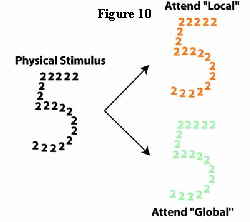Palmeri et al. (2002)
From Psy3242
Participant
The focus of the study was on WO, an adult male who has experienced lexical synesthesia since early childhood. WO's mother, maternal grandfather, and maternal great uncle all experienced synethesia. Lexical synesthesia is characterized by one viewing achromatic words (black, white, grey words) and numbers as colored. Which color goes with which letter and/or number depends on the individual. One person might see the letter A as blue while another might see the same letter as purple. What remains the same, however, is that during synesthesia there is a binding of color to visual forms. It must be noted, though, that synesthesia is not limited to numbers and letters, rarely some individuals experience synesthesia with geometric shapes.
Procedure
First, Palmeri et al (2002) tested WO's color associations with a list of 100 common monosyllabic words. He was tested twice with the sessions separated by more than a month. WO remained 97 percent consistent across the two trials. The researchers, then, tested WO's synesthesia elicited by local and global forms. For instance, researchers constructed the number five out of several smaller number twos. The synethesite could either see the small twos (local form) or the large five (global form)because each number, of course, had its own distinct color. In synesthesia from motion-defined stimuli, WO was able to identify the digit and saw the associated color for each of the digits. In synesthesia from binocularly defined stimuli, Palmeri et al. (2002) created individual digits by using random-dot stereograms, the digit was visible because of the disparity between the dots using 3D red/green glasses. Results from the stroop interference was significantly slowed for WO when the ink colors were incongruent with the synesthetic colors. In tests were WO had to pick out a 2 in a number of 5s, WO was able to pick out the 2 because it "popped out" to him. But when WO had to pick out the 8 among 6s, WO had a harder time because the synesthetic color for 6s and 8s was a similar blusih color. One conclusion from this paper is that "binding in lexical synethesia occurs during central visual processing and not during later more conceptual processing" (Palmeri et al, 4130). The results were consistent with previous research by Similek et al. and Ramachandran and Hubbard.


